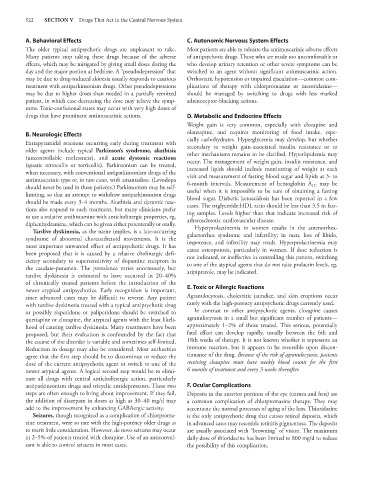Page 536 - Basic _ Clinical Pharmacology ( PDFDrive )
P. 536
522 SECTION V Drugs That Act in the Central Nervous System
A. Behavioral Effects C. Autonomic Nervous System Effects
The older typical antipsychotic drugs are unpleasant to take. Most patients are able to tolerate the antimuscarinic adverse effects
Many patients stop taking these drugs because of the adverse of antipsychotic drugs. Those who are made too uncomfortable or
effects, which may be mitigated by giving small doses during the who develop urinary retention or other severe symptoms can be
day and the major portion at bedtime. A “pseudodepression” that switched to an agent without significant antimuscarinic action.
may be due to drug-induced akinesia usually responds to cautious Orthostatic hypotension or impaired ejaculation—common com-
treatment with antiparkinsonism drugs. Other pseudodepressions plications of therapy with chlorpromazine or mesoridazine—
may be due to higher doses than needed in a partially remitted should be managed by switching to drugs with less marked
patient, in which case decreasing the dose may relieve the symp- adrenoceptor-blocking actions.
toms. Toxic-confusional states may occur with very high doses of
drugs that have prominent antimuscarinic actions. D. Metabolic and Endocrine Effects
Weight gain is very common, especially with clozapine and
B. Neurologic Effects olanzapine, and requires monitoring of food intake, espe-
Extrapyramidal reactions occurring early during treatment with cially carbohydrates. Hyperglycemia may develop, but whether
secondary to weight gain-associated insulin resistance or to
older agents include typical Parkinson’s syndrome, akathisia other mechanisms remains to be clarified. Hyperlipidemia may
(uncontrollable restlessness), and acute dystonic reactions occur. The management of weight gain, insulin resistance, and
(spastic retrocollis or torticollis). Parkinsonism can be treated, increased lipids should include monitoring of weight at each
when necessary, with conventional antiparkinsonism drugs of the visit and measurement of fasting blood sugar and lipids at 3- to
antimuscarinic type or, in rare cases, with amantadine. (Levodopa 6-month intervals. Measurement of hemoglobin A may be
should never be used in these patients.) Parkinsonism may be self- useful when it is impossible to be sure of obtaining a fasting
1C
limiting, so that an attempt to withdraw antiparkinsonism drugs blood sugar. Diabetic ketoacidosis has been reported in a few
should be made every 3–4 months. Akathisia and dystonic reac- cases. The triglyceride:HDL ratio should be less than 3.5 in fast-
tions also respond to such treatment, but many clinicians prefer ing samples. Levels higher than that indicate increased risk of
to use a sedative antihistamine with anticholinergic properties, eg, atherosclerotic cardiovascular disease.
diphenhydramine, which can be given either parenterally or orally. Hyperprolactinemia in women results in the amenorrhea-
Tardive dyskinesia, as the name implies, is a late-occurring
syndrome of abnormal choreoathetoid movements. It is the galactorrhea syndrome and infertility; in men, loss of libido,
impotence, and infertility may result. Hyperprolactinemia may
most important unwanted effect of antipsychotic drugs. It has cause osteoporosis, particularly in women. If dose reduction is
been proposed that it is caused by a relative cholinergic defi- not indicated, or ineffective in controlling this pattern, switching
ciency secondary to supersensitivity of dopamine receptors in to one of the atypical agents that do not raise prolactin levels, eg,
the caudate-putamen. The prevalence varies enormously, but aripiprazole, may be indicated.
tardive dyskinesia is estimated to have occurred in 20–40%
of chronically treated patients before the introduction of the
newer atypical antipsychotics. Early recognition is important, E. Toxic or Allergic Reactions
since advanced cases may be difficult to reverse. Any patient Agranulocytosis, cholestatic jaundice, and skin eruptions occur
with tardive dyskinesia treated with a typical antipsychotic drug rarely with the high-potency antipsychotic drugs currently used.
or possibly risperidone or paliperidone should be switched to In contrast to other antipsychotic agents, clozapine causes
quetiapine or clozapine, the atypical agents with the least likeli- agranulocytosis in a small but significant number of patients—
hood of causing tardive dyskinesia. Many treatments have been approximately 1–2% of those treated. This serious, potentially
proposed, but their evaluation is confounded by the fact that fatal effect can develop rapidly, usually between the 6th and
the course of the disorder is variable and sometimes self-limited. 18th weeks of therapy. It is not known whether it represents an
Reduction in dosage may also be considered. Most authorities immune reaction, but it appears to be reversible upon discon-
agree that the first step should be to discontinue or reduce the tinuance of the drug. Because of the risk of agranulocytosis, patients
dose of the current antipsychotic agent or switch to one of the receiving clozapine must have weekly blood counts for the first
newer atypical agents. A logical second step would be to elimi- 6 months of treatment and every 3 weeks thereafter.
nate all drugs with central anticholinergic action, particularly
antiparkinsonism drugs and tricyclic antidepressants. These two F. Ocular Complications
steps are often enough to bring about improvement. If they fail, Deposits in the anterior portions of the eye (cornea and lens) are
the addition of diazepam in doses as high as 30–40 mg/d may a common complication of chlorpromazine therapy. They may
add to the improvement by enhancing GABAergic activity. accentuate the normal processes of aging of the lens. Thioridazine
Seizures, though recognized as a complication of chlorproma- is the only antipsychotic drug that causes retinal deposits, which
zine treatment, were so rare with the high-potency older drugs as in advanced cases may resemble retinitis pigmentosa. The deposits
to merit little consideration. However, de novo seizures may occur are usually associated with “browning” of vision. The maximum
in 2–5% of patients treated with clozapine. Use of an anticonvul- daily dose of thioridazine has been limited to 800 mg/d to reduce
sant is able to control seizures in most cases. the possibility of this complication.

